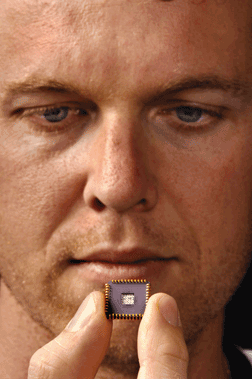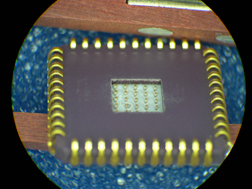NEWS RELEASES
FOR IMMEDIATE RELEASE
August 2, 2005
ElectroNeedles may provide diabetes patients a painless way to check blood glucose levels
Micron-sized µPosts can also diagnose heart attacks by sensing proteins
Albuquerque, N.M.— Two tiny devices recently developed by researchers at the National Nuclear Security Administration's Sandia National Laboratories could mean the elimination of blood drawing by diabetes patients to test glucose levels or by medical personnel to determine if someone is having a heart attack. Test results would be instantaneous.
 JEB FLEMMING, project lead for the ElectroNeedle platform, holds a test version of the device. The prickly parts are in the center of the package. A production version could be even smaller and simpler. (Photo by Randy Montoya)
JEB FLEMMING, project lead for the ElectroNeedle platform, holds a test version of the device. The prickly parts are in the center of the package. A production version could be even smaller and simpler. (Photo by Randy Montoya) Download 300dpi JPEG image (Media are welcome to download/publish this image with related news stories.)
The two arrays of micron-sized needles operate similarly by penetrating painlessly into the skin. Arranged in varying numbers on a small patch, the needles can measure molecules inside the body, eliminating the need to withdraw blood from a patient.
One device is ElectroNeedles, micron-sized electrodes capable of measuring molecules such as glucose that can donate or accept electrons (redox behavior). The other is µPosts, micron-sized posts that have the potential of painlessly measuring proteins and other macromolecules, including protein markers released during a heart attack, using optical measurements. The platforms complement each other and together create a diagnostic suite capable of detecting many important biological markers.
"The tiny ElectroNeedles, expected to be constructed of cheap throw-away plastic, would not only make glucose testing simple and painless, but would significantly cut the diagnostics time involved in protein analysis," says Jeb Flemming, Sandia project leader. "Because the analysis is done inside the body, the need to withdraw body fluid is eliminated, and because the needles are so small the measurements are painless."
Flemming and fellow researchers David Ingersoll and Carrie Schmidt came up with the idea for the ElectroNeedles and µPosts while working on a Sandia-funded Bio-MicroFuel Cell research project where Flemming investigated harvesting sugars from living plants and animals. Some of that internal money funded early ElectroNeedle and µPost work.
It wasn't until they hired Colin Buckley, a medical student from the University of New Mexico Medical School, that the team realized the significance of their invention. "Colin gave us a much-needed insight into the medical diagnostic field," says Flemming.
The team realized that the tips of each of the ElectroNeedles and µPosts could be coated with a biologically active layer capable of measuring concentrations of specific lipids, proteins, antibodies, toxins, viruses, and carbohydrates (such as glucose). Using the ElectroNeedles and rapid electrochemical methods for analysis, a measurement can be made in a few seconds. Likewise, using coated µPosts to capture proteins and other non-redox behaving molecules, optical measurements can potentially be made in less than a half hour.
"Multiple chemical platforms, such as µPosts, will change medical diagnostics by giving the physician a greater understanding of the health of the patient in a shorter amount of time than standard laboratory analysis used today in medicine," Buckley says.
The arrays may be configured in a variety of formats - larger or smaller to accommodate different applications.
 Closeup of ElectroNeedle (Media are welcome to download/publish this image with related news stories.)
Closeup of ElectroNeedle (Media are welcome to download/publish this image with related news stories.)The ElectroNeedles and µPosts can be tailored in size to sample in different portions of the skin. For example, they can be made shorter to measure small-molecular-weight compounds such as glucose in the upper layer of the skin, or they can be made longer to measure larger molecules in the blood, such as Troponin I, a key protein released when a person has a heart attack.
"Today if someone goes to an emergency room with chest pains the doctor assesses the patient's condition based on their symptoms. In order to accurately diagnose a patient the doctor has to take a blood sample, which is typically sent to an off-site laboratory for analysis," Flemming says. "The person usually has to wait six hours to get confirmation on whether they have elevated Troponin I levels indicating they have had a heart attack."
With a µPost test a doctor would know within a couple of minutes of a patient's arrival at the emergency room if the patient has elevated Troponin I levels, as most of the diagnostics can take place inside an ambulance during a patient's trip to the hospital.
"There would be little to no pain associated with this," Flemming says. "The only thing the patient would feel is a slight itching."
ElectroNeedles and µPosts now exist as a prototype and are made of Foturan®, a glass-like material. The intent is to ultimately mass-produce them from an inexpensive plastic.
The devices have been used to measure glucose and Troponin I within pig skin, with the next step to test them on pig skin with blood.
The technological advances at Sandia have led to several patents pending.
Sandia is a multiprogram laboratory operated by Sandia Corporation, a Lockheed Martin company, for the U.S. Department of Energy's National Nuclear Security Administration. Sandia has major R& D responsibilities in national security, energy and environmental technologies, and economic competitiveness.
Sandia media contact: Chris Burroughs, (505) 844-0948, coburro@sandia.gov
Sandia technical contact: Jeb Flemming, (505) 844-2230, jhflemm@sandia.gov